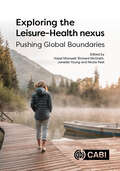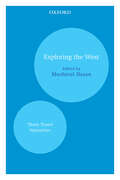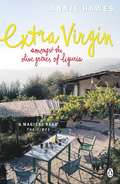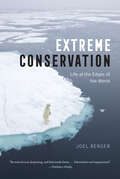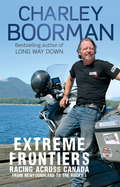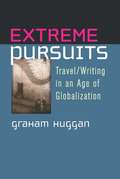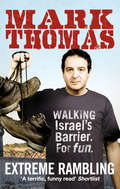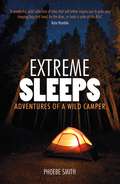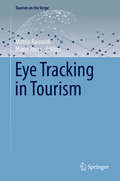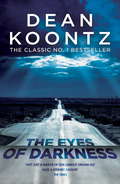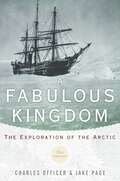- Table View
- List View
Exploring the Leisure - Health Nexus: Pushing Global Boundaries
by Lynn Anderson Holly Bowen-Salter Nina Burridge Simon Darcy Katherine Dashper Christina Davies Leila Gholizadeh Simone Grabowski Tonia Gray Sara Karacsony Alexis Marcoux Rouleau Danielle McDonald Annette Michelsen Cour Emma Milanese Torben Nielsen Carmel Nottle Jenny Onyx Michelle O’Shea Victoria Paraschak Sonya Pearce Melanie Pescud Arianne Reis Joyce Simard Zoei SuttonBy exploring past, current, and future intersections between leisure and health, this book considers research and academic thought to reveal and critique the nuanced ways that leisure impacts health as well as considering how health professions use leisure as a 'tool'. Aided by the diverse chapters, readers will be challenged to explore future intersections between leisure and health using an overarching eco (ecological/environmental), bio(biological), psycho (psychological), social (sociological) lens. Many of the chapters include case-studies which consider further developing leisure and health themes, particularly in relation to a number of emerging environmental, health and societal challenges that confront the world. In addition, the book: ·Is cross disciplinary and demonstrates non-individualized framing of health (as per the WHO definition) giving readers a unique opportunity to develop an understanding of sociological frameworks, including ecobiopyschosocial, salutogenic, multi-species and criticalist. ·Moves readers from an individual level understanding of interconnections between leisure and health through to a consideration of global issues (including a section on the impact and consequences of Covid-19). ·Examines the nexus between leisure and health through a focus on a number of population groups including First Nations peoples, women, incarcerated people, migrants, people with disabilities, older people, and the human-animal interface. The book will be of significant interest to researchers/academics/practitioners in the leisure, health, sport, tourism, recreation, events, social science, and arts disciplines.
Exploring the Thames Wilderness: A Guide to the Natural Thames
by Richard Mayon-White Wendy YorkeThe River Thames is an often undiscovered haven of stunning scenery, wonderful wildlife and brilliant natural beauty. As well as the famous stretches passing through our biggest cities and towns, there is a hidden side to the river - wild and natural, but surprisingly accessible. This guidebook, compiled by the two major Thames charities, contains a wealth of information on over 150 of the best places to explore the real Thames wilderness, along with enjoyable walks and activities along its course. Organised geographically, the book gives information on the history and character of each stretch of the river and the featured sites within it, travelling from source to sea. Illustrated with maps and photos, the text highlights which plants and wildlife to watch out for, activities you can do, how to get there and nearby moorings, cycle paths and car parks. Each section features a circular walk, tying together several of the sites and accompanied by an enchanting hand-drawn map. An essential source of ideas for days out and handy for on the go, Exploring the Thames Wilderness opens up the beauty of the Thames to everyone.
Exploring the West: Three Travel Narratives
by Mushirul HasanInverting the conventional imagery of Europeans' travel narratives about South Asia, this omnibus brings together three fascinating accounts of Indian interaction with the West. It raises interesting questions about cross-cultural encounters. Is the West objectively perceived and represented? Do observers colour fact with fiction? Do they talk of an East–West divide? The first volume is an account of Itesamuddin's travel (1766–9) to Europe. Set in the context of the grant of Diwani to the British in India, Images of the West, offers fresh insights on the state and everyday life in England discussing questions of religious controversies, military, and law. Its author also gives us a panoramic view of the socio-cultural life, flora and fauna, and education and lifestyles. Abu Taleb's travelogue provides a non-Western representation of the West, sheds light on the national customs and manners of Europeans. Westward Bound, comprises his impressions of England, France, Genoa, Malta, Turkey, and Baghdad during his travels (1799–1803). His understanding of cultural streams in the East and West provide an alternative viewpoint on the encounter between Pax Brittanica and the sharif families of North India. Seamless Boundaries presents the autobiography of Lutfullah Khan, one of the earliest known works by an Indian in English. Traversing geographical and cultural boundaries, Lutfullah's narrative defies conventional labels. He explores events, people, and their culture beyond the mere east–west dichotomies. He also presents a graphic account of his voyage to England in 1844. Mushirul Hasan's introduction explores the life and times of these travellers. Arguing for exploring the West and the Muslim societies from an unsentimental and wide-ranging perspective, he investigates the discourse on East–West relations, and highlights the significance of travel narratives as historical records in the production of knowledge.
Extra Virgin: A Young Woman Discovers The Italian Riviera, Where Every Month Is Enchanted
by Annie HawesA small stone house deep among the olive groves of Liguria, going for the price of a dodgy second-hand car. Annie Hawes and her sister, on the spot by chance, have no plans whatsoever to move to the Italian Riviera but find naturally that it's an offer they can't refuse. The laugh is on the Foreign Females who discover that here amongst the hardcore olive farming folk their incompetence is positively alarming. Not to worry: the thrifty villagers of Diano San Pietro are on the case, and soon plying the Pallid Sisters with advice, ridicule, tall tales and copious hillside refreshments ...
Extraction to Extinction: Rethinking our Relationship with Earth's Natural Resources
by David HoweEverything we use started life in the earth, as a rock or a mineral vein, a layer of an ancient seabed, or the remains of a long-extinct volcano.Humanity’s ability to fashion nature to its own ends is by no means a new phenomenon. Rocks rich in silica were made into flints in the Stone Age, transformed into stained glass in medieval times, and are now extracted for silicon chips. Our trick of turning rocks rich in malachite and chalcopyrite into copper has taken us from Bronze Age Minoan vases to the wiring that powers modern-day machinery.Today, we mine, quarry, pump, cut, blast and crush the Earth’s resources at an unprecedented rate. We shift many times more rock, soil and sediment each year than the world’s rivers and glaciers, wind and rain combined. Plastics alone now weigh twice as much as all the marine and terrestrial animals around the globe. We have become a dominant, even dangerous, force on the planet.In Extraction to Extinction, David Howe traces our environmental impact through time to unearth how our obsession with endlessly producing and throwing away more and more stuff has pushed the planet to its limit. And he considers the question: what does the future look like for our depleted world?
Extraordinary People: A stunning cold-case mystery from the #1 bestseller (Enzo 1) (The Enzo Files #1)
by Peter May**#1 BESTSELLING AUTHOR: OVER 3 MILLION COPIES SOLD** **THE ENZO FILES: PETER MAY'S ADDICTIVE COLD-CASE SERIES** **'Action-packed' ENTERTAINMENT WEEKLY** **'Enzo MacLeod is one of the most unusual crime solvers I have ever met' BOOKBROWSE**In the first book of the Enzo Files, ex forensic scientist Enzo Macleod makes a daring wager and attempts to solve the ten-year-old case of a vanished manPARIS.An old mystery. As midnight strikes, a man desperately seeking sanctuary flees into a church. The next day, his sudden disappearance will make him famous throughout France. A new science. Forensic expert Enzo Macleod takes a wager to solve the seven most notorious French murders, armed with modern technology and a total disregard for the justice system. A fresh trail. Deep in the catacombs below the city, he unearths dark clues deliberately set - and as he draws closer to the killer, discovers that he is to be the next victim.LOVED EXTRAORDINARY PEOPLE? Read book 2 in the series, THE CRITICLOVE PETER MAY? Order his new thriller, A SILENT DEATH
Extreme Conservation: Life at the Edges of the World
by Joel Berger"Extraordinary. . . . Berger is a hero of biology who deserves the highest honors that science can bestow."—Tim Flannery, New York Review of Books On the Tibetan Plateau, there are wild yaks with blood cells thinner than those of horses’ by half, enabling the endangered yaks to survive at 40 below zero and in the lowest oxygen levels of the mountaintops. But climate change is causing the snow patterns here to shift, and with the snows, the entire ecosystem. Food and water are vaporizing in this warming environment, and these beasts of ice and thin air are extraordinarily ill-equipped for the change. A journey into some of the most forbidding landscapes on earth, Joel Berger’s Extreme Conservation is an eye-opening, steely look at what it takes for animals like these to live at the edges of existence. But more than this, it is a revealing exploration of how climate change and people are affecting even the most far-flung niches of our planet. Berger’s quest to understand these creatures’ struggles takes him to some of the most remote corners and peaks of the globe: across Arctic tundra and the frozen Chukchi Sea to study muskoxen, into the Bhutanese Himalayas to follow the rarely sighted takin, and through the Gobi Desert to track the proboscis-swinging saiga. Known as much for his rigorous, scientific methods of developing solutions to conservation challenges as for his penchant for donning moose and polar bear costumes to understand the mindsets of his subjects more closely, Berger is a guide par excellence. He is a scientist and storyteller who has made his life working with desert nomads, in zones that typically require Sherpas and oxygen canisters. Recounting animals as charismatic as their landscapes are extreme, Berger’s unforgettable tale carries us with humor and expertise to the ends of the earth and back. But as his adventures show, the more adapted a species has become to its particular ecological niche, the more devastating climate change can be. Life at the extremes is more challenging than ever, and the need for action, for solutions, has never been greater.
Extreme Conservation: Life at the Edges of the World
by Joel Berger"Extraordinary. . . . Berger is a hero of biology who deserves the highest honors that science can bestow."—Tim Flannery, New York Review of Books On the Tibetan Plateau, there are wild yaks with blood cells thinner than those of horses’ by half, enabling the endangered yaks to survive at 40 below zero and in the lowest oxygen levels of the mountaintops. But climate change is causing the snow patterns here to shift, and with the snows, the entire ecosystem. Food and water are vaporizing in this warming environment, and these beasts of ice and thin air are extraordinarily ill-equipped for the change. A journey into some of the most forbidding landscapes on earth, Joel Berger’s Extreme Conservation is an eye-opening, steely look at what it takes for animals like these to live at the edges of existence. But more than this, it is a revealing exploration of how climate change and people are affecting even the most far-flung niches of our planet. Berger’s quest to understand these creatures’ struggles takes him to some of the most remote corners and peaks of the globe: across Arctic tundra and the frozen Chukchi Sea to study muskoxen, into the Bhutanese Himalayas to follow the rarely sighted takin, and through the Gobi Desert to track the proboscis-swinging saiga. Known as much for his rigorous, scientific methods of developing solutions to conservation challenges as for his penchant for donning moose and polar bear costumes to understand the mindsets of his subjects more closely, Berger is a guide par excellence. He is a scientist and storyteller who has made his life working with desert nomads, in zones that typically require Sherpas and oxygen canisters. Recounting animals as charismatic as their landscapes are extreme, Berger’s unforgettable tale carries us with humor and expertise to the ends of the earth and back. But as his adventures show, the more adapted a species has become to its particular ecological niche, the more devastating climate change can be. Life at the extremes is more challenging than ever, and the need for action, for solutions, has never been greater.
Extreme Conservation: Life at the Edges of the World
by Joel Berger"Extraordinary. . . . Berger is a hero of biology who deserves the highest honors that science can bestow."—Tim Flannery, New York Review of Books On the Tibetan Plateau, there are wild yaks with blood cells thinner than those of horses’ by half, enabling the endangered yaks to survive at 40 below zero and in the lowest oxygen levels of the mountaintops. But climate change is causing the snow patterns here to shift, and with the snows, the entire ecosystem. Food and water are vaporizing in this warming environment, and these beasts of ice and thin air are extraordinarily ill-equipped for the change. A journey into some of the most forbidding landscapes on earth, Joel Berger’s Extreme Conservation is an eye-opening, steely look at what it takes for animals like these to live at the edges of existence. But more than this, it is a revealing exploration of how climate change and people are affecting even the most far-flung niches of our planet. Berger’s quest to understand these creatures’ struggles takes him to some of the most remote corners and peaks of the globe: across Arctic tundra and the frozen Chukchi Sea to study muskoxen, into the Bhutanese Himalayas to follow the rarely sighted takin, and through the Gobi Desert to track the proboscis-swinging saiga. Known as much for his rigorous, scientific methods of developing solutions to conservation challenges as for his penchant for donning moose and polar bear costumes to understand the mindsets of his subjects more closely, Berger is a guide par excellence. He is a scientist and storyteller who has made his life working with desert nomads, in zones that typically require Sherpas and oxygen canisters. Recounting animals as charismatic as their landscapes are extreme, Berger’s unforgettable tale carries us with humor and expertise to the ends of the earth and back. But as his adventures show, the more adapted a species has become to its particular ecological niche, the more devastating climate change can be. Life at the extremes is more challenging than ever, and the need for action, for solutions, has never been greater.
Extreme Conservation: Life at the Edges of the World
by Joel Berger"Extraordinary. . . . Berger is a hero of biology who deserves the highest honors that science can bestow."—Tim Flannery, New York Review of Books On the Tibetan Plateau, there are wild yaks with blood cells thinner than those of horses’ by half, enabling the endangered yaks to survive at 40 below zero and in the lowest oxygen levels of the mountaintops. But climate change is causing the snow patterns here to shift, and with the snows, the entire ecosystem. Food and water are vaporizing in this warming environment, and these beasts of ice and thin air are extraordinarily ill-equipped for the change. A journey into some of the most forbidding landscapes on earth, Joel Berger’s Extreme Conservation is an eye-opening, steely look at what it takes for animals like these to live at the edges of existence. But more than this, it is a revealing exploration of how climate change and people are affecting even the most far-flung niches of our planet. Berger’s quest to understand these creatures’ struggles takes him to some of the most remote corners and peaks of the globe: across Arctic tundra and the frozen Chukchi Sea to study muskoxen, into the Bhutanese Himalayas to follow the rarely sighted takin, and through the Gobi Desert to track the proboscis-swinging saiga. Known as much for his rigorous, scientific methods of developing solutions to conservation challenges as for his penchant for donning moose and polar bear costumes to understand the mindsets of his subjects more closely, Berger is a guide par excellence. He is a scientist and storyteller who has made his life working with desert nomads, in zones that typically require Sherpas and oxygen canisters. Recounting animals as charismatic as their landscapes are extreme, Berger’s unforgettable tale carries us with humor and expertise to the ends of the earth and back. But as his adventures show, the more adapted a species has become to its particular ecological niche, the more devastating climate change can be. Life at the extremes is more challenging than ever, and the need for action, for solutions, has never been greater.
Extreme Frontiers: Racing Across Canada from Newfoundland to the Rockies
by Charley BoormanCharley Boorman is back on his bike exploring the world's second largest country - home to some of the most stunning and challenging terrain known to man. Canada is a country of extremes, and Charley knows all about pushing the limits. He goes dirt biking in New Brunswick, dives through old shipwrecks in Tobermory and rides along Butch Cassidy's old Outlaw Trail. He also meets a fascinating mix of people on his journey. As he heads across Canada, he plays ice hockey with a legend of the game; spends a day as a Mountie cadet and nearly meets a ghost in Winnipeg . . . Written with Charley's trademark enthusiasm and humour, Extreme Frontiers is fast-paced, hugely entertaining and packed with adventure (and rather a lot of mosquitoes).
Extreme Pursuits: Travel/Writing in an Age of Globalization
by Graham HugganRecent figures suggest that there will be 1.6 billion arrivals at world airports by the year 2020. Extreme Pursuits looks at the new conditions of global travel and the unease, even paranoia, that underlies them---at the opportunities they offer for alternative identities and their oscillation between remembered and anticipated states. Graham Huggan offers a provocative account of what is happening to travel at a time characterized by extremes of social and political instability in which adrenaline-filled travelers appear correspondingly determined to take risks. It includes discussions of the links between tourism and terrorism, of contemporary modes of disaster tourism, and of the writing that derives from these; but it also confirms the existence of more responsible forms of travel/writing that demonstrate awareness of a chronically endangered world. Extreme Pursuits is the first study of its kind to link travel writing explicitly with structural changes in the global tourist industry. The book makes clear that travel writing can no longer take refuge in the classic distinctions (traveler versus tourist, foreigner versus native) on which it previously depended. Such distinctions---which were dubious in the first place---no longer make sense in an increasingly globalized world. Huggan argues accordingly that the category "travel writing" must include experimental ethnography and prose fiction; that it should concern itself with other kinds of travel practices, such as those related to Holocaust deportation and migrant labor; and that it should encompass representations of travelers and "traveling cultures" that appear in popular media, especially TV and film. Graham Huggan is Professor of Commonwealth and Postcolonial Literatures at the University of Leeds. He is the coauthor, with Patrick Holland, of Tourists with Typewriters: Critical Reflections on Contemporary Travel Writing (University of Michigan Press) and coauthor, with Helen Tiffin, of Postcolonial Ecocriticism (Routledge). Illustration: "Shadow Wall," 2006 © Shaun Tan.
Extreme Rambling: Walking Israel's Separation Barrier. For Fun.
by Mark Thomas'Good fences make good neighbours, but what about bad ones?'The Israeli separation barrier is probably the most iconic divider of land since the Berlin Wall. It has been declared illegal under international law and its impact on life in the West Bank has been enormous.Mark Thomas - as only he could - decided the only way to really get to grips with this huge divide was to use the barrier as a route map, to 'walk the wall', covering the entire distance with little more in his armoury than Kendal Mint Cake and a box of blister plasters.In the course of his ramble he was tear-gassed, stoned, sunburned, rained on and hailed on and even lost the wall a couple of times. But thankfully he was also welcomed and looked after by Israelis and Palestinians - from farmers and soldiers to smugglers and zookeepers - and finally earned a unique insight of the real Middle East in all its entrenched and yet life-affirming glory. And all without hardly ever getting arrested!
Extreme Sleeps: Adventures of a Wild Camper
by Phoebe SmithGlobetrotter Phoebe Smith sets out to prove that outdoor adventures are available in the UK which rival anything found elsewhere in the world. In this sometimes scary and frequently funny journey around the country, Phoebe attempts to conquer its wildest places, defy her perceptions of the great outdoors and teach her about herself along the way.
Extreme South
by James CastrissionOn 31 October 2011 James Castrission and Justin Jones set out to achieve 'one of the last great polar adventures' - an unsupported return journey from the edge of the Antarctic continent to the South Pole. This is a quest that has been attempted by many experienced polar explorers before them...and all have failed. This book details everything - the preparation, the setbacks, the outset, the highs and the lows - all in brutally honest detail. This expedition is the modern-day equivalent of the exploits of Scott, Amundsen and Shackleton and Castrission and Jones man-hauled a pulk (with 200kg of provisions each), utilising prevailing winds with kites when possible. Why do this? Through realising a childhood dream and committing themselves to a groundbreaking expedition, these two intrepid blokes hope to inspire others to overcome fear and pursue their own adventures and dreams.
Extreme Tourism: Lessons from the World's Cold Water Islands
by Godfrey BaldacchinoThis book is a pioneering investigation of the tourism practices in the world's other, cold water, islands. Located in extreme latitudes and subject to extreme weather conditions, these islands have been developing their tourism appeal in manners that appear sustainable. They present themselves in images that speak to the pristine, unique and superlative aspects of their natural environment, history and culture. Limited seasonality, difficulty of access, restricted infrastructure, harsh climates and water too cold to swim in, are integral features of the tourism industry, often welcomed as appropriate filters to the slide to the mass market. The collection contains 13 island case studies. A set of seven hail from Northern latitudes: Baffin (Nunavut, Canada), Banks (Northwest Territories, Canada), Greenland/ Kaalaalit Nunaat, Iceland, Luleå (Sweden), Nunivak (Alaska), Solovetsky (Russia) and Svalbard (Norway). A second set of four cover the Southerly islands of Chatham (New Zealand), Falklands, Macquarie (Australia) and Stewart (New Zealand). Two other chapters discuss islands from the particular vantage points of cruise ship tourism, one for the Arctic region and one for the Antarctic. Additionally, five conceptual chapters provide insights into key tourism management issues, as they apply to cold water island experiences:(a) human resources; (b) environment; (c) promotion; (d) seasonality; and (e) access.
Extreme Tourism: Lessons from the World's Cold Water Islands
by Godfrey BaldacchinoThis book is a pioneering investigation of the tourism practices in the world's other, cold water, islands. Located in extreme latitudes and subject to extreme weather conditions, these islands have been developing their tourism appeal in manners that appear sustainable. They present themselves in images that speak to the pristine, unique and superlative aspects of their natural environment, history and culture. Limited seasonality, difficulty of access, restricted infrastructure, harsh climates and water too cold to swim in, are integral features of the tourism industry, often welcomed as appropriate filters to the slide to the mass market. The collection contains 13 island case studies. A set of seven hail from Northern latitudes: Baffin (Nunavut, Canada), Banks (Northwest Territories, Canada), Greenland/ Kaalaalit Nunaat, Iceland, Luleå (Sweden), Nunivak (Alaska), Solovetsky (Russia) and Svalbard (Norway). A second set of four cover the Southerly islands of Chatham (New Zealand), Falklands, Macquarie (Australia) and Stewart (New Zealand). Two other chapters discuss islands from the particular vantage points of cruise ship tourism, one for the Arctic region and one for the Antarctic. Additionally, five conceptual chapters provide insights into key tourism management issues, as they apply to cold water island experiences:(a) human resources; (b) environment; (c) promotion; (d) seasonality; and (e) access.
Extremely Pale Rose: A Quest for the Palest Rose in France
by Jamie IveyA chance conversation with a Provençal vigneron leads to the most unlikely of quests - a hunt to find France's palest rosé. Extremely Pale Rosé is a richly entertaining and informative account of the travels of Jamie, his wife Tanya and their ebullient friend Peter, as they take up this challenge. Giving up their lives in London, they quickly discover an unfortunate truth - the French won't treat rosé or their quest seriously. Rosé is seen as a poor cousin to red and white wine, drunk as an aperitif or to wash away the taste of spicy food. In bars, boulangeries and boucheries from Bordeaux to Bandol, Jamie, Tanya and Peter are recommended diverse vineyards to visit, and as they travel they encounter the beginnings of a rosé revolution - French attitudes to pale pink wine appear to be changing, but is it too little too late to help them succeed in their quest? With wit, candour and wonderful storytelling, Jamie Ivey maintains a tradition of excellence in food and travel writing. Readers are left with dreams of France, summer days, baguettes, and . . . extremely pale rosé.
Eye of the Raven: the thrilling new Viking adventure in the Whale Road Chronicles (The Whale Road Chronicles #7)
by Tim HodkinsonPREORDER EYE OF THE RAVEN, THE EXCITING NEW VIKING ADVENTURE FROM TIM HODKINSON, NOW!Alone in a foreign land, Viking warrior Einar must choose his loyalties in the face of war. The gripping new instalment in the Whale Road Chronicles. For the first time, Einar and the Wolf Coats find themselves divided, on opposing sides in a time of warfare: the Wolf Coats in Ireland, and Einar in the Saxon domains of England.Einar leads a warband for King Aethelstan, but struggles to find acceptance as a Norseman in Saxon lands. Can he truly make common cause with the wily king of the English, if that means Vikings like himself are now his enemies? The rewards of alliance with Aethelstan could be all he desires... or a brutal death. But other threats loom from the north and west. With war brewing and a great battle on the horizon, can Einar and his comrades reunite in time - or will a clash for the ages make their split a permanent one?
An Eye on the Hebrides: New Edition
by Mairi HedderwickMairi Hedderwick embarks on a six-month-long journey to 40 islands from Arran to Lewis, recounting her pilgrimage around the archipelago of the Western Isles with which she has had a lifelong love affair.Filled with wit and wisdom that is matched by her spell-binding illustrations, Mairi Hedderwick portrays the islands in all their diversity, with swift and perceptive cameos of everyday life drawn with humour and affection alongside gorgeous landscapes which capture the truly magical beauty of the Hebrides.
Eye Tracking in Tourism (Tourism on the Verge)
by Mario Jooss Mattia RainoldiDespite the ever-increasing interest in eye tracking, there is still no comprehensive work on the potential and applications of table-mounted and mobile head-mounted eye tracking solutions in travel and tourism. This volume bridges that gap, effectively linking eye tracking with travel and tourism. It presents, on the one hand, novel academic contributions on the concept of eye tracking, and on the other, practice-oriented case studies that illustrate the use and strategic value of eye tracking in travel and tourism. It provides concrete and novel insights into tourist behavior and the tourist consumer experience and, for the academic community, offers a comprehensive, scientifically based overview of the empirical, methodological, theoretical, and practical contributions of eye tracking research. Accordingly, the book will be of value to a diverse audience. It will be a useful resource for existing and future tourism businesses, allowing them to adopt proactive approaches in the design of tourism products. It will also stimulate further research in the field and inspire scholars and practitioners to combine their ideas and expertise, to look beyond supposedly fixed horizons, and to identify emerging opportunities.
The Eyes of Darkness: A terrifying horror novel of unrelenting suspense (Los Jet De Plaza And J Ser.)
by Dean KoontzA search for a missing son... and a haunting truth. The Eyes of Darkness is a gripping thriller of a mother's search for her son that unlocks deadly secrets, from bestselling author Dean Koontz. Perfect for fans of Stephen King and Richard Laymon.'Dean Koontz is a prose stylist whose lyricism heightens malevolence and tension. [He creates] characters of unusual richness and depth' - The Seattle Times It's a year since Tina Evans lost her little boy Danny in a tragic accident, a year since she began the painful process of trying to rebuild her life. Then a shattering message appears on the blackboard in Danny's old room: NOT DEAD.Is it someone's idea of a grim joke? Or the tangible evidence of her tormented unconscious? Or something more?The search for an answer, the search for Danny, demands a courage and endurance beyond any that Tina thought she possessed. Only her love for her son, and her love for the one man who believes her, drives her on, through the neon clamour of Las Vegas nightlife, the sun-scorched desert, and the frozen mountains of the High Sierra. People die, coldly, brutally, as a buried truth struggles to surface. A truth so incredible, so frightening, so dangerous that its secret must be kept at the price of any life - any man, any woman...any child. What readers are saying about The Eyes of Darkness: 'Full of suspense and mystery and a light coating of the supernatural''Great plot and suspense, kept me on the edge of my seat''Five stars'
The Faber Book of Reportage
by Professor John Carey***FEATURED ON BBC 2's BETWEEN THE COVERS WITH SARA COX***The Faber Book of Reportage is John Carey's remarkable collection of eyewitness accounts that draws on the voices and emotions of the people who experienced some of history's most memorable events.'Stunning . . . There are descriptions in this book so fresh that they sear themselves into the imagination.'JEREMY PAXMAN'Fascinating - there's funny stuff, interesting stuff, loads of brilliant stuff really.'JO BRAND (on BBC 2's Between the Covers)What was it like to be caught in the firestorm that destroyed Pompeii? To have dinner with Attila the Hun? To watch the charge of the Light Brigade? To see the Titanic slide beneath the waves? John Carey's best-selling Faber Book of Reportage draws its eyewitness account from memoirs, travel books and newspapers. This is history with the varnish removed.
A Fabulous Kingdom: The Exploration of the Arctic
by Charles Officer Jake PageInconstant and forbidding, the arctic has lured misguided voyagers into the cold for centuries--pushing them beyond the limits of their knowledge, technology, and endurance. A Fabulous Kingdom charts these quests and the eventual race for the North Pole, chronicling the lives and adventures that would eventually throw light on this "magical realm" of sunless winters. They follow the explorers from the early journeys of Viking Ottar to the daring exploits of Martin Frobisher, Henry Hudson, Frederick Cook, Robert Peary, and Richard Bird. The second edition features a section entitled "The New Arctic" that illuminates current scientific and environmental issues that threaten the region. Officer and Page discuss such topics as the science behind the melting of the polar ice; the endangered species that now depend on the ice, including polar bears, narwhals, walruses, and ringed seals; commerce in mining and natural resources, especially petroleum and natural gas; and predictions for the economic and environmental future of the region. Library Journal called the first edition a "winning fusion of adventure, suspense, and history."
A Fabulous Kingdom: The Exploration of the Arctic
by Jake Page Charles OfficerInconstant and forbidding, the arctic has lured misguided voyagers into the cold for centuries--pushing them beyond the limits of their knowledge, technology, and endurance. A Fabulous Kingdom charts these quests and the eventual race for the North Pole, chronicling the lives and adventures that would eventually throw light on this "magical realm" of sunless winters. They follow the explorers from the early journeys of Viking Ottar to the daring exploits of Martin Frobisher, Henry Hudson, Frederick Cook, Robert Peary, and Richard Bird. The second edition features a section entitled "The New Arctic" that illuminates current scientific and environmental issues that threaten the region. Officer and Page discuss such topics as the science behind the melting of the polar ice; the endangered species that now depend on the ice, including polar bears, narwhals, walruses, and ringed seals; commerce in mining and natural resources, especially petroleum and natural gas; and predictions for the economic and environmental future of the region. Library Journal called the first edition a "winning fusion of adventure, suspense, and history."
